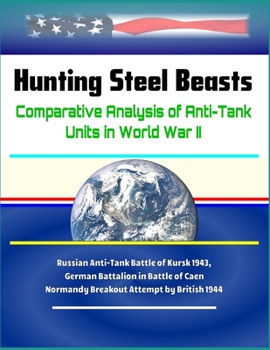Hunting Steel Beasts: Comparative Analysis of Anti-Tank Units in World War II - Russian Anti-Tank Battle of Kursk 1943, German Battalion in
In order to fight and win in large-scale combat operations, the Army must think of and employ corps and divisions as fighting formations instead of simply headquarters organizations. Over the course of the Global War on Terror, the Army focused on employing the modular Brigade Combat Team as the tactical echelon of choice in warfighting. Over the past few decades, the Anti-Tank units in particular disappeared almost completely from the U.S. Army's organization. The study is significant because there is potentially a lack of dedicated organic anti-tank capability in U.S. Army divisions and corps. Given the threats that the U.S. Army could do battle with in the future in large scale combat operations, there exists certain biases that suggest that American technological advantages can close operational and tactical gaps with our adversaries. Anti-Tank units are legacy formations that employed low-tech options to destroy armor. This capability seems to get overlooked in the modern high-tech Multi-Domain concept battle of the future. Historical case studies from World War II were selected for examination because of the use of Anti-Tank units at the operational level of war. This study conducts a structured, focused comparison of two World War II historical case studies that examine Anti-Tank units in the defense by asking six research questions related to operational art. These questions focus on testing three hypotheses concerning Anti-Tank units providing operational flexibility, preventing culmination, and enabling a quick transition to the offense. The empirical evidence examined partially supports this monograph's thesis that Anti-Tank units provide lethality to divisions and corps in the defense. The evidence from both case studies supports the hypotheses that Anti-Tank units provided operational flexibility and prevented culmination of the defense, but did not support the hypothesis that Anti-Tank units enabled a quick transition to the offense.This compilation also includes a reproduction of the 2019 Worldwide Threat Assessment of the U.S. Intelligence Community.The study is significant because there is potentially a lack of dedicated organic anti-tank capability in U.S. Army divisions and corps. Given the threats that the U.S. Army could do battle with in the future in large-scale combat operations, there exists certain biases that suggest that American technological advantages can close operational and tactical gaps with our adversaries. Anti-Tank units are legacy formations that employed low-tech options to destroy armor. This capability seems to get overlooked in the modern high-tech Multi-Domain concept battle of the future. In addition, the doctrine for Anti-Tank units in the U.S. Army has not been updated for some time. However, going back to the formation of the first U.S. Army Anti-Tank units created before World War II, the doctrine existed before the capability did in anticipation of future needs. The potential added lethality that Anti-Tank units provide divisions and corps will be analyzed through the characteristics of the defense and operational art. In order to establish shared understanding, certain key terms need to be defined. Operational flexibility is a characteristic of the defense in which the defender who is agile enough to counter or evade the attacker's blow can then strike back effectively. Culmination is the point in time and space at which a force no longer possesses the capability to continue its current form of operations.
Format:Paperback
Language:English
ISBN:1700910361
ISBN13:9781700910363
Release Date:January 1
Publisher:Independently Published
Length:82 Pages
Weight:0.47 lbs.
Dimensions:0.2" x 8.5" x 11.0"
Related Subjects
HistoryCustomer Reviews
0 rating





